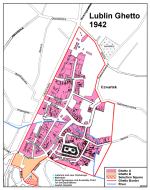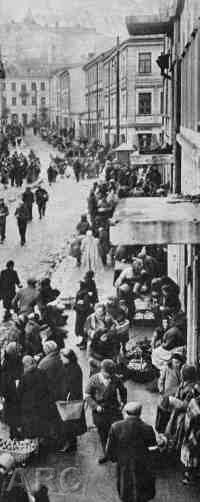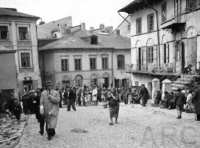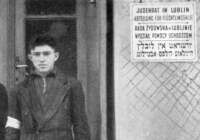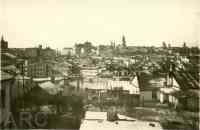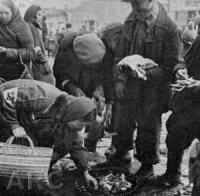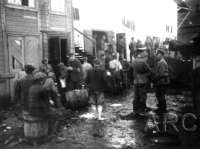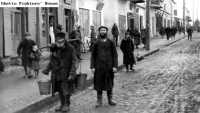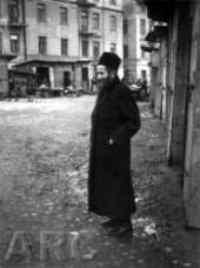 |
| A Jew in the Lublin Ghetto |
On
16 March 1942, several hours before the beginning of the ghetto liquidation,
SS-Hauptsturmführer
Hermann Höfle met the representatives of all Nazi institutions
in Lublin. They were informed that all
unemployed Jews would be deported to
Belzec "which is the last station in Lublin
district", and "that these people never will come back. For the Jewish workers the SS is building a big camp
(
Majdanek) which will be main reservoir of the Jewish labour power for the
German factories in the town". He promised that during the deportation the SS would select people for work.
At 10 p.m. the ghetto was surrounded by SS and Ukrainians from
Trawniki. They lit
the main ghetto street, which shocked the people being driven from their homes. Many of them, especially
the elderly and sick were killed on the spot. Two hours later
SS-Hauptsturmführer
Hermann Worthoff from the
Gestapo Lublin, being responsible for Jewish affairs, met the
Judenrat. He ordered that every day
around 1,500 people had to be deported "
to the East, for work". Everyone would be allowed to take 15 kg
of luggage on the journey, along with valuables and money.
Meanwhile the first group of Jews were brought to the Great Synagogue, now being used as a gathering
centre for the deportees. On this night they were brought to the
Umschlagplatz near the town slaughterhouse.
Early on the morning of
17 March 1942 the first Lublin Jews were deported to the
Belzec extermination camp.
At this time none of the Jews knew about the fate of these deportees nor the destination
of the transports. But several days after the beginning of the deportation a young boy (his name is unknown)
escaped from
Belzec. Returning to Lublin he explained the fate of the deportees.
Nobody wanted to believe him.
Until
14 April 1942 about 26,000 Lublin Jews were sent to
Belzec.
About 200 children from the Jewish Orphanage were executed together with their
teachers in a Lublin suburb. Several hundred patients from the hospitals were shot at
Niemce
Forest (15 km from Lublin), together with their doctors and nurses.
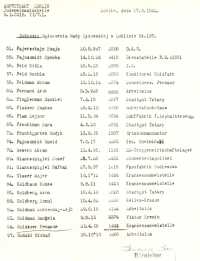 |
| Majdan Tatarski Forced Labourers |
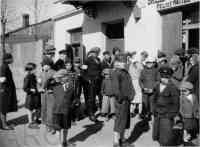 |
| Lublin Jews #3 |
During the ghetto "action" the SS changed their regulations regarding the "Work Jews". All those working for
the Germans had to change their ID card into a
Juden-Ausweis. These people were exempt from the next
deportations. According to this SS order only 2,500 Jews were allowed to stay in the ghetto officially.
On
30 March 1942 Worthoff ordered the selection of the
Judenrat members and other officials. The
president of Lublinís
Judenrat Ing.
Henryk Bekker and other
members (among them Dr
Josef Siegfried
who was president of the
Jüdische Soziale Selbsthilfe in Lublin) were deported to
Belzec the same day.
Ing.
Bekker probably knew the fate of his fellow sufferers:
He went to the deportation train wearing ritual Jewish clothing and without any luggage. Together with the
Judenrat members, 35 Jewish policemen and their families were deported.
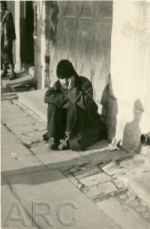 |
| Lublin Jew |
Deportations halted on
14 April 1942. The SS knew that around 7,000-8,000 Jews still tried to
hide themselves in cellars in the old ghetto dwellings. Therefore
Worthoff
and the
Gestapo staff (responsible for the deportations: Dr
Harry Sturm, Walther
Knitzky and Kalich) ordered the transfer of all remaining Jews
to the small ghetto of
Majdan Tatarski in a Lublin suburb.
Majdan Tatarski was located in the neighbourhood of the forced labour
camp at
Flugplatz (Airfield). The Jews
who were in this ghetto could even observe their comrades working at the
Flugplatz camp. There the
possessions of the
Aktion Reinhard victims were sorted. Before the war roughly 1,500 Polish people lived
in
Majdan Tatarski, mainly workers from the aircraft factory
Plage-Laskiewicz. In the new ghetto many
people had to spend their nights on the streets and courtyards due to lack of space.
On
22 April 1942 about 2,500-3,000 people, mostly women with children, having no
J-Ausweis (Identity
Card for Jews), were taken to
Majdanek concentration camp. After this selection
about 2,000-2,500 people were shot at
Krepiec Forest and 200-300 young men were selected for
Majdanek concentration camp.
Rumours about their fate spread among the ghetto prisoners. Many of them could no longer believe in survival.
In
Majdan Tatarski 4,000 Jews still resided there.
After this selection the
Majdan Tatarski ghetto was organized as a closed ghetto,
surrounded by barbed wire.
The president of the new Lublin
Judenrat was Dr
Marek Alten, but the
man with the biggest influence in the ghetto was
Shama Grajer, before
the war a barber and owner of the Old Town brothel. During the war
he was an intimate with the
Gestapo in the ghetto. At his
Lubartowska Street restaurant the SS deportation
staff gathered. He provided them with the best of drinks and Jewish musicians.
Grajer even sold
J-Ausweise for many
people, taking thousands of zlotys, and participated in the SS corruption. In
Majdan Tatarski everyone
called him the "Jewish King". He participated in the next selections and decided who would be
selected for
Majdanek.
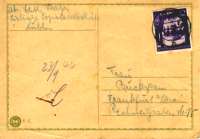 |
| Ghetto Postcard |
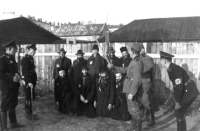 |
| Humiliated Jews * |
In
September 1942 about 1,000 Jews were deported to the ghetto in
Piaski near Lublin. The next selection took
place on
24 October. Among the deportees a group of so called "privileged" Jews
(officials of the Ghetto
Arbeitsamt (job centre) and workers from
Victor Kreminís company) who were exempt from the deportations
until then were taken to
Majdanek concentration camp.
On
9 November 1942, according to
Himmlerís
order that June (to finish the deportations from the ghettos in the
Generalgouvernement to the
death and concentration camps until the
end of December 1942), a last group of
about 3,000 Jews from
Majdan Tatarski was
deported to
Majdanek. About
180 people were shot in the ghetto, most of them children and people wanting to hide themselves in cellars.
Hermann Worthoff
personally shot Dr
Marek Alten, Shama Grajer and Moniek Goldfarb
who was commander of the Jewish ghetto police. They were killed by personal order of
Odilo Globocnik in order to eliminate all witnesses of SS corruption.
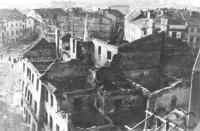 |
| Lublin Ghetto Ruins 1943 |
In
Majdanek new transports were selected: Old people and children were sent to
the gas chambers, people being able to work remained alive. From
Majdanek
some prisoners were brought to other forced labour camps in Lublin:
7 Lipowa Street,
Flugplatz,
Sportplatz or several smaller work places. Specialists were transferred
to the
Gestapo prison in the castle where they had to work as
Hofjuden, personal slaves for
the
Gestapo officers and their families.
Some Lublin Jews who survived until
November 1943 were executed during the mass
execution of all Jewish prisoners on
3 November 1943 at
Majdanek. This execution, the largest in the history of all
concentration camps, is known as
Aktion Erntefest ("Operation Harvest Festival"). On this day around
18,000 Jews from different camps in Lublin were executed at
Majdanek.
The last group of 400-500 Lublin Jews, working at the Castle, survived until
July 1944.
Together with many Polish political prisoners they were shot on
21 and 22 July 1944,
a few hours before the Red Army liberated the city. The person responsible for organising these executions was
Hermann Worthoff, the same man who had earlier liquidated the Lublin Ghetto and
been complicit in the liquidation of the
Warsaw Ghetto.
The Jews killed in
July 1944 at the Castle had been selected by him as
so-called "
Hofjuden", working for the Lublin
Gestapo. They had been rescued by
Worthoff during "
Aktion Erntefest" (some of them were transferred from
7 Lipowa Street Camp to the Castle) but he ordered them killed at the very last moment
before the arrival of the Soviet Army (the Soviets were by that time in the suburbs of Lublin). Only two or three Jews
survived from this group. The Polish political prisoners killed that day were mainly those who were under investigation
by
Worthoff and had been sentenced to death during the final period
of the occupation (
May-June 1944).
Only 200-300 of formerly 40,000 Lublin Jews survived in hiding or were finally liberated from a number of different
concentration camps. About 1,000 Jews survived the war in Soviet areas.
The Lublin Ghetto was the first ghetto in the
Generalgouvernement to be liquidated, and the Nazis gained
much experience, for future deportation actions. Jews from Lublin were the first victims of the newly
constructed death camp at
Belzec.
The Lublin Album
Photos:
GFH
*
ZIH Warsaw
*
Marek Gromaszek
*
Sources:
State Archive in Lublin:
Collection of Lublinís Judenrat 1939-1942; Collection of Governor
of Lublin District 1939-1944.
Archive of the Majdanek State Museum:
Collection of Survivorís Memoirs and Testimonies.
Institute of the National Remembrance in Warsaw:
Records from the trials against Hermann
Worthoff and Dr. Harry Sturm.
N. Blumental:
Documents From Lublin Ghetto. Judenrat Without Direction. Jerusalem 1967.
S. Erlichman-Bank:
Listy z piekla. Bialystok 1992.
S. Goldberg (Chehever):
The Undefeated. Tel-Aviv 1985.
J. Kasperek:
Kronika wydarzen w Lublinie w okresie okupacji hitlerowskiej. Lublin 1983.
R. Kuwalek, W. Wysok:
Lublin - Jerozolima Krůlestwa Polskiego. Lublin 2001.
T. Radzik:
Lubelska dzielnica zamknieta. Lublin 1999.
© ARC (http://www.deathcamps.org) 2005












